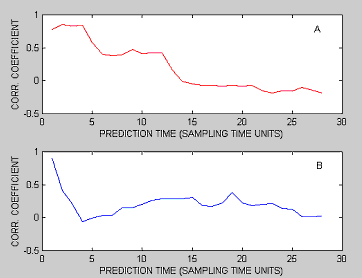

So far, the human red blood cell has been viewed as an elastic bag, encapsulating a high concentration of hemoglobin and functioning as a passive oxygen carrier. Our study provides a new insight into the organization of various physical and chemical subsystems that constitute the human red blood cell.
The measurement of CMF was carried out by a recently developed method of precise detection of nano-scale movements enabling us to study these fluctuations with a relatively high spatial (up to a few nanometers) and temporal (up to milliseconds) resolution. We have carried out our measurements on active living human RBC and compared it to inactive RBC following chemical cross-linking treatment with glutaraldehyde.
We studied prediction efficiencies for living and inactive human RBCs. The prediction efficiency gradually drops with the increase of the prediction time for a living RBC (Fig. A). In contrast to this, the prediction efficiency for an inactive RBC drops much faster then for an active one (Fig. B). The dependence of the correlation coefficient on the prediction interval does not exhibit a simple structure possessing e.g. a constant slope, but reveals a rather multi-step decrease.
The prediction efficiency analysis followed by the surrogate analysis supports the hypothesis that chaotic dynamics underlies the recorded time series of membrane fluctuations of an active RBC. It should be noted that RBCs pretreated with glutaraldehyde still manifest attenuated surface fluctuations. Nevertheless, the exposure of the living cell to a cross-linking agent results in mechanical restriction of the membrane-skeleton combined with unspecific inhibition of many enzymatic activities in the membrane and cytosol, and this is sufficient to abolish the features of nonlinear dynamics. The interrelationship between metabolic processes inside a living cell and characteristics of the mechanical motion of the outer membrane promises to be a noninvasive approach to obtain the information about cell metabolism without the use of complicated biochemical analytical tools.
